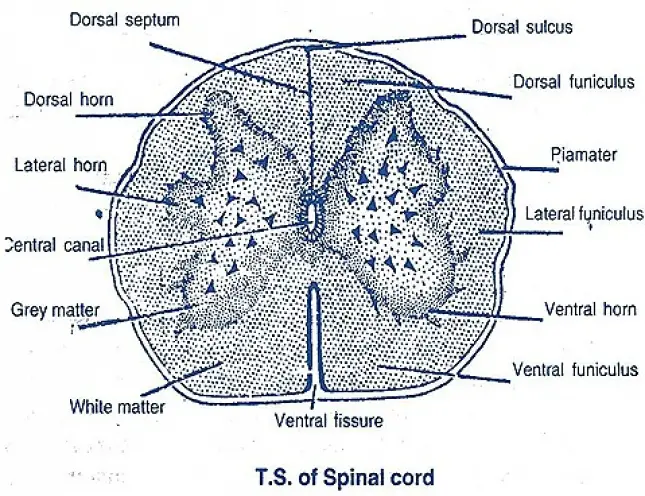Medically reviewed and approved by a board-certified member

The spinal cord is the second part of central nervous system. The medulla oblongata is continued behind into a spinal cord. It comes out through foramen of magnum and runs through neural canal of vertebral column. Just like brain the spinal cord is also covered by three meninges viz., outer duramater, middle arachnoid membrane and inner piamater.
In Rabbit, the spinal cord is elongated, more or less cylindrical, bilaterally symmetrical and slightly flattened in dorsoventral direction. The spinal cord terminates into a tapering filament called filum terminale which lies in the urostyle. The spinal cord is swollen at the level of fore limbs and hind limbs toformtwo conspicuous enlargement^^ Anteitorjenlargement of the spinal cord present at the level of fore limbs is called brachial enlargement, while the posterior enlargement lying between hind limbs is called sciatic enlargement.
There are two longitudinal fissures in mid dorsal and mid ventral regions of spinal cord. They are known as dorsal fissure and ventral fissure. The ventral fissure is more conspicuous than the dorsal fissure and it contains blood vessels. The fissures divide the spinal cord into right and left halves.
In the centre of the spinal cord there is a canal called central canal. This canal is lined by a single layer of ciliated epithelial cells. Anteriorly, it is in continuation with the cavities of the brain and ends blindly at the posterior end. Surrounding central canal there is a grey matter. It consists of nerve cell bodies and proximal parts of axons. The corners of the grey matter is produced into a pair of dorsal and a pair of ventral horns.
The grey matter is surrounded by white matter. The white matter consists of myelinated parts of axons. The white matter is divided int four zones, viz., a dorsal funiculus, ventral funiculus and two lateral funiculi. This zonation is formed due to the horns of the grey matter stretched into the white matter. The dorsal half of the spinal cord is sensory and ventral half is motor in function.
End of the article